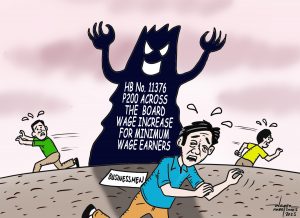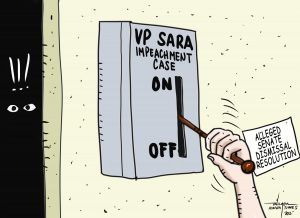We congratulate the officials of Sta. Ana Multi-purpose Cooperative (SAMULCO) for maintaining the coop’s being an apolitical organization.During its 52nd General Assembly last Sunday held at the CYO gymnasium of the Holy Cross of Davao College (HCDC) in Davao City not a single tarpaulin or whatever campaign poster of candidates in both local and national elective positions was seen in the vicinity of the assembly area. The officials themselves never mentioned any name of candidates that would expose their collective and individual choices.
Of course, they invited one of two incumbent Coop-NATCO Partylist congressmen who stayed only for a while to listen to the cooperative’s chair of the Board of Directors thank the Partylist lawmakers who have worked for the continuing tax exemption of cooperatives in the country, Sta. Ana included. And perhaps to show gratitude, the guest Coop-NATCO Partylist lawmaker was allowed by the cooperative’s chair a little time to pitch for the group he currently represents in the House of Representatives with one other. The guest lawmaker from Coop-NATCO also mentioned in his short speech names of four senators two of them from Mindanao, for helping the cooperatives’ cause in the Senate.
On the whole however, there was no indication that the SAMULCO was showing its favor to any political bets.
Our kudos to SAMULCO Board of Director’s chair Dr. Victor Hofilena Jr. who steered the assembly proceedings with a dexterity not even found in some supposed political leaders.
**********************
In our almost daily trips to downtown Davao City we have witnessed the sudden change in the landscapes along our usual route. Walls and fences, tree trunks and utility poles have become almost totally wrapped or plastered with campaign paraphernalia of various sizes many of which are in violation of the sizes prescribed by the Commission on Elections (COMELEC).
We have also noticed how some candidates in connivance with their supporters (kuno), wantonly bastardize the provision in the 1987 Constitution which authorizes the creation of Partylist groups to give representation to the supposed “disadvantaged” sectors of society in the country’s lawmaking body.
How does this bastardization happen? Look, it is not only one but many Partylist organizations have suddenly surfaced from out of the blue like mushrooms on the grounds of large banana plantations. One such Partylist group can even be mistaken as seeking representation in the Senate when in fact it is only applicable in the Lower House. And who would not mistake that Partylist as seeking representation in the Senate when on its campaign posters are pictures of two senatorial candidates. Are we now electing Partylist members for the Senate?
Another Partylist group whose existence as creation of certain political organization is quite overt is the one that can easily be associated with public utility drivers. Some of its campaign posters bear pictures of a now emerging national figure raising the hand of another person. Of course it can easily be deduced that the person whose hand was raised by the up-and-coming national politician is the top nominee of the said Partylist group to Congress,
However, it is intriguing to see the up-coming (and fast) national politician raising the hand of the nominee. Therefore, we can be certain that there is some kind of trade-off between that Partylist group and the endorsing fast-rising national political figure. What this trade is, we will surely know possibly immediately before the May 13, 2019 elections or on the days when the next Congress opens and its new leaders have to be elected or affirmed.
Yes, we are only presenting in this particular column of ours two of the most blatant cases of bastardization of the Partylist provisions of the Constitution. We are however, extremely saddened at how inutile the Commission on Elections (COMELEC) in its vetting process for Partylist applicants for accreditation.
Imagine the abject failure of the poll body to see the clarity of the opportunistic schemes of some groups pushing for the approval of the accreditation of these and those Partylist applicant organizations. Their number purports that most, if not all, of the constituency of the congressmen coming from the existing legitimate political parties, are not represented in the national legislature.
So, what is the use of electing so many congressmen whose number is equivalent to the total number of congressional districts in the entire country.After all, if we refer to the number of Partylist groups accredited by the COMELEC, it would appear that the congressmen elected from the mainstream political parties have no more constituents to represent?
Well, if the President still considers his avowed commitment to change the present Constitution with a new one, maybe the issue of over representation can already be addressed. Perhaps the government can save a huge amount of money paying for the salaries and wages of so many congressmen and their office staff and consultants, and travels as well.



